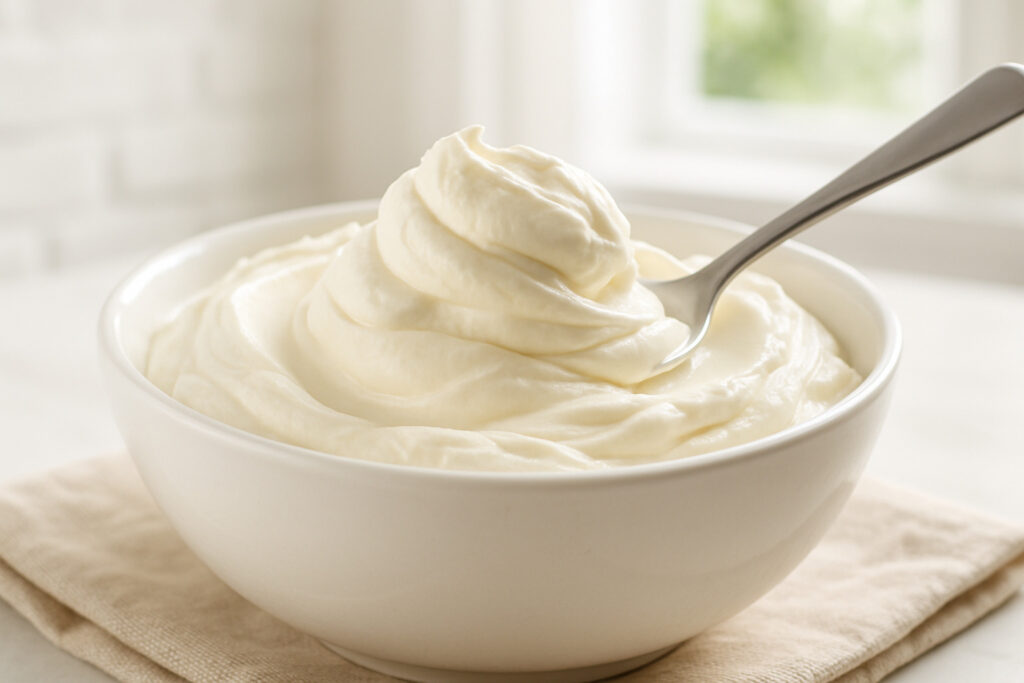Why Understanding Mascarpone’s Unique Taste Matters for Food Lovers
What does mascarpone taste like? This Italian cream cheese offers a delicately sweet and buttery flavor with a subtle acidic finish and an exceptionally smooth, velvety texture that melts on your tongue. Unlike tangy cream cheese, mascarpone is mild and naturally sweet with no sharp bite.
Quick Taste Profile:
- Flavor: Buttery, mildly sweet, slight acidity
- Texture: Smooth, creamy, spreadable
- Fat Content: 60-75% (much richer than cream cheese)
- Tanginess: Very low compared to other fresh cheeses
- Mouthfeel: Melts instantly, coating sensation
Originating from Lombardy in Northern Italy during the Renaissance, mascarpone has captivated food enthusiasts for centuries. This triple-cream cheese is made by heating heavy cream and adding acid – a simple process that creates something truly special.
For culinary travelers and food lovers, understanding mascarpone opens doors to authentic Italian experiences. Whether you’re exploring New York City’s Italian restaurants or planning your next food trip, knowing this ingredient helps you appreciate both classic dishes like tiramisu and modern culinary innovations.
The high butterfat content (up to 75%) gives mascarpone its signature richness that’s far sweeter and less tangy than cream cheese, ricotta, or crème fraîche. This makes it incredibly versatile – equally at home in desserts and savory dishes.
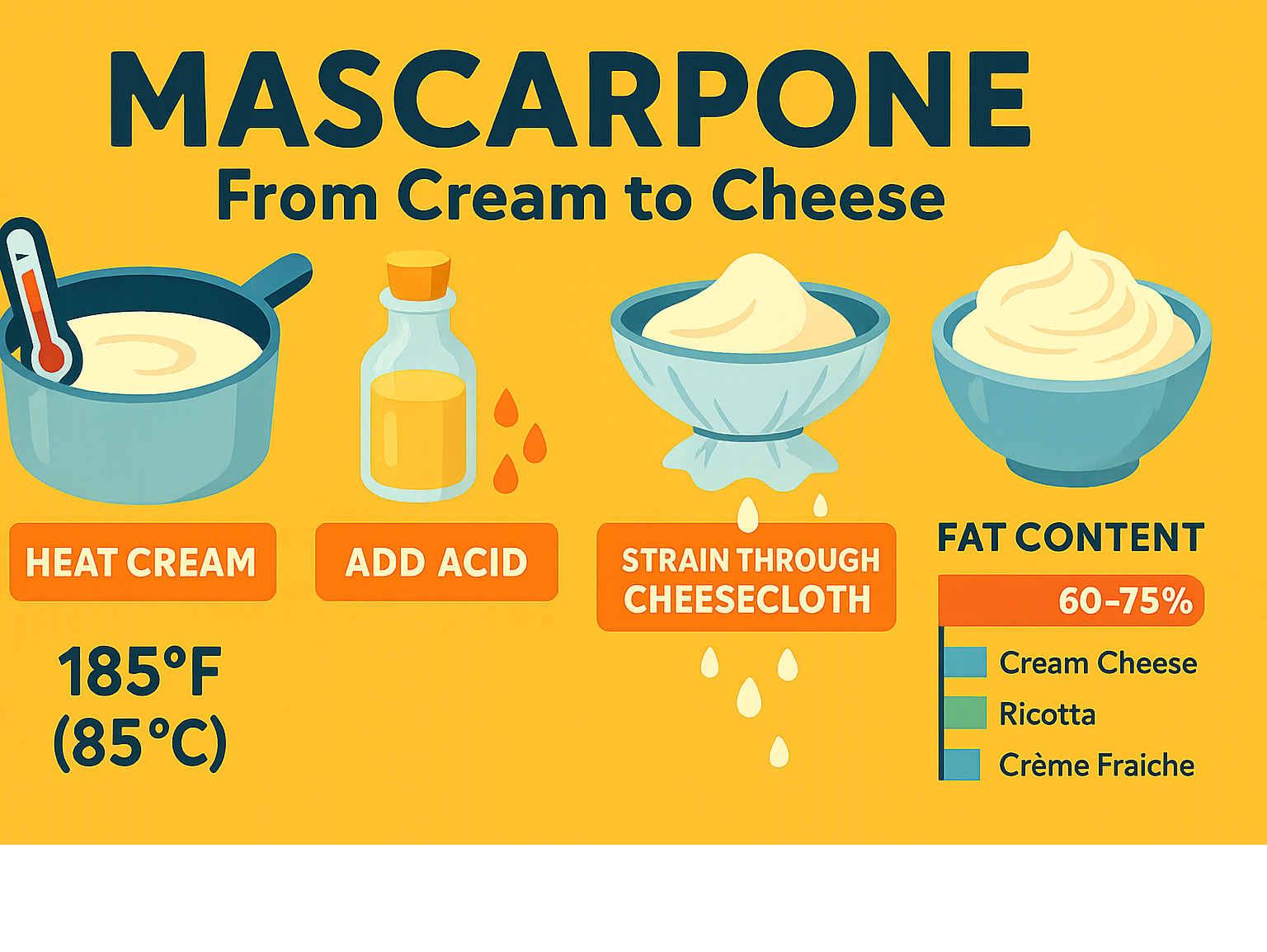
Mascarpone 101: Definition, Pronunciation & How It’s Made
Picture this: you’re in a charming Italian market, and you confidently ask for “mas-car-POH-nay” instead of stumbling over “MAR-sca-pone” like most tourists. That’s the correct pronunciation of this beloved Italian treasure, and getting it right shows you truly understand what mascarpone taste like and its cultural importance.
The name itself tells a story. “Mascarpone” likely comes from the old Lombard word “mascarpa,” meaning quark – quite humble origins for something so luxurious! This cream cheese has been gracing Italian tables since the late 16th or early 17th century, born in the rolling hills of Lombardy where happy cows grazed on herb-rich pastures.
Today, mascarpone holds PAT status (prodotto agroalimentare tradizionale), Italy’s official recognition for traditional agricultural products. This isn’t just bureaucratic paperwork – it’s Italy’s way of saying “this is the real deal, and we’re proud of it.”
The region’s exceptional dairy tradition created the perfect storm for mascarpone’s invention. Those Lombard cows, munching on aromatic mountain herbs, produced cream so rich and flavorful that local cheese makers couldn’t help but experiment. The result? Pure magic in a bowl.
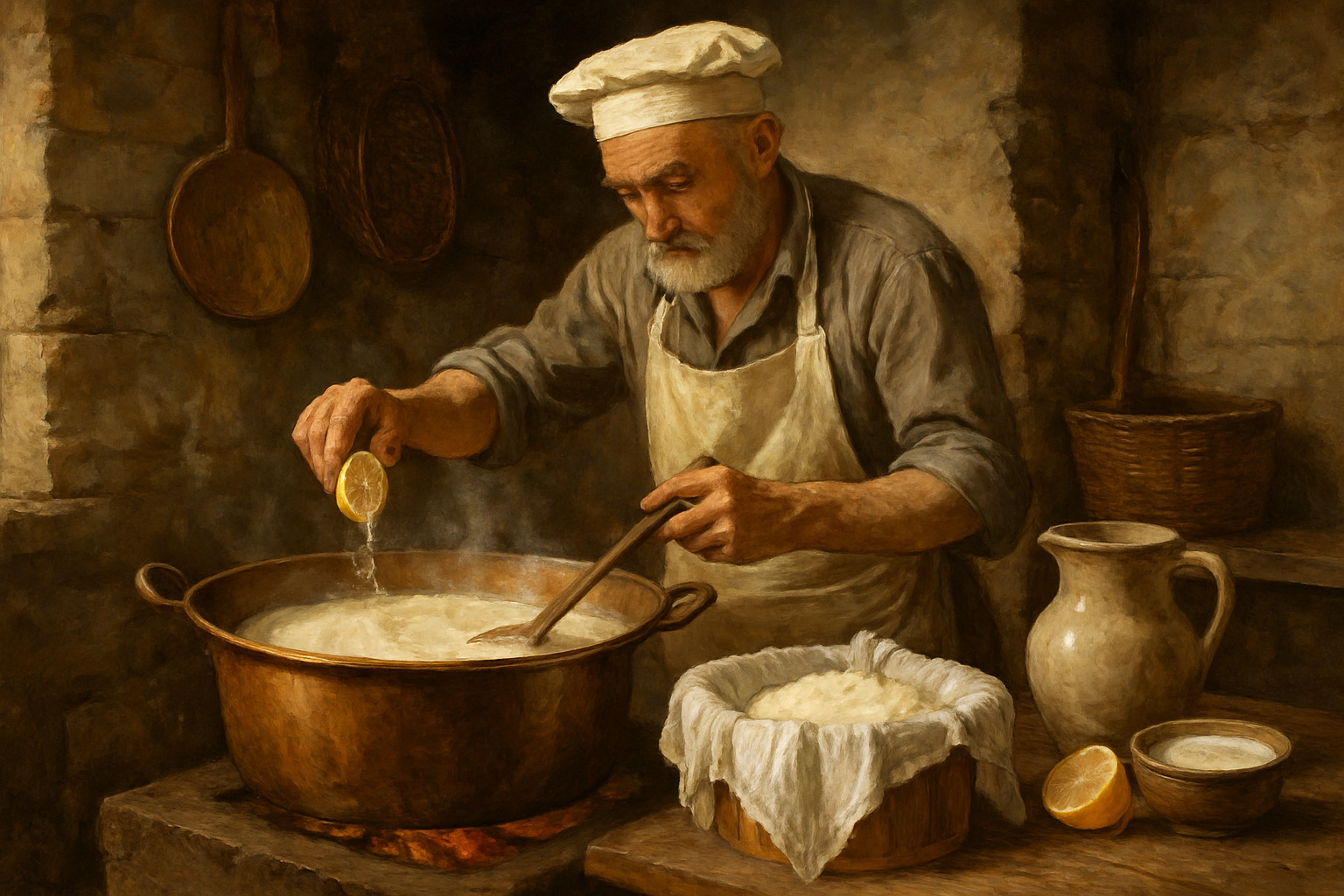
Step-by-Step Production
Here’s the beautiful simplicity of mascarpone: you need just two ingredients to create something extraordinary. Heavy cream with 35-40% butterfat and an acid – traditionally fresh lemon juice, though modern producers often use citric or tartaric acid for consistent results.
The magic happens at exactly 185-190°F. Heat your cream to this precise temperature (any hotter and you’ll get scrambled cream, any cooler and it won’t set properly). Then comes the moment of change – whisk in the acid and watch as the silky cream begins to thicken and coagulate.
After cooking for about 3 minutes until the mixture coats the back of a spoon, you’ll cool it down and begin the waiting game. The mixture gets strained through cheesecloth for 8-24 hours, allowing the whey to slowly drip away. This patience pays off – what remains is that gorgeous, ivory-colored mascarpone with its signature velvety texture.
The whole process takes less than 10 minutes of actual work, though the chilling and straining period tests your patience. Many home cooks love making small batches because it’s surprisingly forgiving and incredibly fresh-tasting.
Is Mascarpone a Cheese or a Cream?
This question stumps even food lovers! Technically, mascarpone is classified as a fresh cheese under Italian law, even though it’s made entirely from cream rather than milk. The key is in the process – that acid-coagulation method fits the legal definition of cheese-making.
With its whopping 60-75% butterfat content, mascarpone earns the title of triple-cream cheese. To put this richness in perspective, regular cream cheese contains only about 33% fat. That means mascarpone is nearly twice as rich – no wonder it tastes so indulgent!
This extraordinary fat content explains everything about mascarpone’s character. It’s why the cheese has that pale ivory color, that ultra-smooth spreadable consistency, and that luxurious mouthfeel that makes it so different from other fresh cheeses. When you understand these numbers, you truly grasp what makes mascarpone taste like pure dairy heaven.
What Does Mascarpone Taste Like?
What does mascarpone taste like? Imagine the richest, creamiest butter you’ve ever tasted, but smoother and with a gentle sweetness that makes your taste buds sing. That’s mascarpone in a nutshell.
When you first taste this Italian treasure, you’ll notice its incredibly buttery-sweet flavor that feels like pure indulgence. There’s no sharp tang or bite here – just a mild, pleasant acidity that keeps things balanced without overwhelming your palate. The dairy aroma is clean and inviting, reminiscent of the finest heavy cream with subtle nutty undertones that add depth to each bite.
The beauty of mascarpone lies in its simplicity. It tastes like what cream dreams of becoming – concentrated, refined, and absolutely luxurious. Some food lovers detect hints of floral notes, especially in artisanal varieties made from cream produced by cows grazing on herb-rich pastures.
Unlike aged cheeses with complex flavor profiles, mascarpone keeps things neatly simple. It’s the dairy equivalent of a perfect white canvas – rich enough to stand alone, yet versatile enough to improve whatever it touches.
Scientific research on fat & flavor
Is Mascarpone Sweet or Tangy?
Here’s where mascarpone really shines – it’s delightfully sweet without being cloying. The natural sweetness comes from the cream itself and the gentle acid treatment during production, creating a dessert-friendly flavor that works beautifully in both sweet and savory dishes.
What does mascarpone taste like compared to other fresh cheeses? Think of it as the gentle giant of the cheese world. While cream cheese delivers a sharp tang and ricotta can be slightly grainy and tart, mascarpone offers subtle sweetness with just enough acidity to prevent richness overload.
This perfect balance makes it incredibly versatile. You can literally eat it straight from the container as a treat (and trust us, many people do), or use it to create show-stopping desserts and neat savory dishes.
How to Describe Mascarpone at First Bite?
Taking your first spoonful of quality mascarpone is like experiencing dairy nirvana. The texture hits you first – velvety and custard-like, it melts instantly on your tongue while leaving that luxurious, coating sensation that only high-fat dairy can provide.
The flavor unfolds in waves. First comes that rich, buttery creaminess that makes you close your eyes and savor the moment. Then the gentle sweetness emerges, followed by a whisper of acidity that cleanses your palate and leaves you wanting more.
What does mascarpone taste like to first-timers? Many describe it as “eating a cloud made of butter” or “the world’s most neat cream.” It’s remarkably smooth and refined, with none of the graininess you might find in lesser dairy products. The creamy mouthfeel is so distinctive that once you’ve experienced real mascarpone, you’ll recognize it anywhere.
Flavor Face-Off: Mascarpone vs. Cream Cheese, Ricotta, Crème Fraîche & Clotted Cream
When you’re exploring what does mascarpone taste like, it helps to compare it with other creamy dairy products you might already know. Think of this as your taste bud roadmap to understanding why mascarpone is so special.
Mascarpone versus cream cheese reveals the biggest difference right away – mascarpone contains a whopping 60-75% fat compared to cream cheese’s modest 33%. That’s nearly twice as rich! While cream cheese hits you with that familiar tang and firm spreadability, mascarpone greets your palate with buttery sweetness and silk-smooth luxury. Cream cheese can be sharp and acidic, but mascarpone? It’s all mellow richness.
The ricotta comparison is fascinating because they look similar but taste completely different. Ricotta has that distinctive grainy, fluffy texture from its curd structure, while mascarpone flows like velvet. Ricotta tastes mild with slightly mineral notes, but mascarpone delivers pure creamy sweetness. Plus, ricotta’s much lower fat content makes it lighter – though far less indulgent.
Crème fraîche brings its own personality to the table with 30-40% fat and a notable tang from bacterial fermentation. It’s thinner than mascarpone and sharper, with complex nutty undertones that develop during culturing. When you taste them side by side, mascarpone feels sweeter and richer with barely any acidity.
Clotted cream comes closest to mascarpone’s richness level, but even here there are differences. Clotted cream has a slightly granular texture and deeper, more concentrated dairy flavor from its heating process. It’s less sweet than mascarpone and carries that distinctive cooked-cream taste that makes it perfect for scones but different for desserts.
| Comparison | Fat Content | Texture | Flavor Profile | Tang Level |
|---|---|---|---|---|
| Mascarpone | 60-75% | Silky smooth | Buttery, sweet | Very low |
| Cream Cheese | 33% | Firm, spreadable | Tangy, sharp | High |
| Ricotta | 10-15% | Grainy, fluffy | Mild, mineral | Low |
| Crème Fraîche | 30-40% | Thick, pourable | Complex, nutty | Medium-high |
| Clotted Cream | 55-64% | Slightly grainy | Rich, cooked | Low-medium |
When to Substitute & What Changes in Taste
Sometimes you need mascarpone but can’t find it, or maybe you’re curious about experimenting. Here’s what happens when you make swaps – and how it changes what does mascarpone taste like in your final dish.
Cream cheese substitutions work best when you soften one cup of cream cheese and blend it with 1/4 cup heavy cream. This gets you closer to mascarpone’s richness, though you’ll still taste more tang and less smoothness. In cheesecakes, this swap works surprisingly well, though tiramisu purists might notice the difference.
Ricotta blends require some finesse – use fine-curd ricotta and blend it until completely smooth for the best texture match. The flavor becomes milder and less buttery, which is particularly noticeable in desserts where mascarpone’s sweetness usually shines. You might want to add a touch of cream to boost richness.
Crème fraîche works beautifully in savory applications like finishing risotto or enriching pasta sauces, but it adds unwanted sharpness to sweet dishes. Use equal amounts, but expect more complex, tangy flavors that can actually improve savory recipes.
Clotted cream makes the closest substitute in terms of pure richness and mouthfeel. It’s less sweet with more pronounced cooked-cream flavors, but in many dessert applications, it delivers similar luxury. The texture impact on your recipe will be minimal, though the flavor shifts slightly toward deeper dairy notes.
These substitutions change your dish’s personality. Sometimes that’s exactly what you want – a tangier cheesecake or a sharper pasta sauce. Other times, like with authentic tiramisu, only mascarpone delivers that perfect buttery sweetness that makes the dessert sing.
Texture, Nutrition & Dietary Insights
When you first scoop mascarpone with a spoon, you’ll immediately notice its spreadable-silk texture – it’s like the creamiest butter you’ve ever encountered, but somehow even smoother. At room temperature, it spreads effortlessly, while chilled, it holds its shape beautifully yet still feels luxuriously soft on your palate.
What does mascarpone taste like in terms of mouthfeel? Imagine the richest custard melting instantly on your tongue, leaving behind a velvety coating that makes every bite feel indulgent. This extraordinary texture comes from those densely packed butterfat globules working their magic.
Now, let’s talk numbers – because understanding mascarpone’s nutritional profile helps explain why it tastes so incredibly rich. At 429 calories per 100g, this isn’t exactly diet food, but those calories come with good reason. A single tablespoon (about 28g) delivers approximately 120 calories, with 12g of fat making up the bulk of that energy.
The breakdown tells the whole story: you’re getting 9g of saturated fat, just 1g each of carbohydrates and protein, plus 35mg of cholesterol and a modest 15mg of sodium per tablespoon. Those 60-75% butterfat levels aren’t just impressive statistics – they’re the secret behind mascarpone’s incredible taste and texture.
For food lovers with dietary concerns, mascarpone offers some pleasant surprises. It’s naturally gluten-free and perfectly vegetarian-friendly, making it accessible for many different eating styles. While it does contain lactose, the production process converts much of it to lactic acid, which means people with mild lactose sensitivity often tolerate it better than regular milk products.
Expecting mothers can generally enjoy pasteurized mascarpone safely, though it’s always wise to check labels. Unpasteurized versions carry potential Listeria risks, so stick with commercial brands that clearly state their pasteurization process.
Latest research on mascarpone nutrition
Fat Content & Mouthfeel Science
Here’s where things get fascinating from a culinary science perspective. Those butterfat globules in mascarpone aren’t just sitting there – they’re creating a complex sensory experience every time you taste it. When mascarpone hits your mouth temperature, those fat molecules release concentrated flavor compounds gradually, which is why the taste seems to unfold and linger.
The rich coating sensation you feel isn’t just psychological – it’s your taste buds responding to that extraordinary 60-75% fat content. This high fat level acts like a natural flavor carrier, intensifying every subtle note while creating that satisfying feeling of satiation that makes mascarpone so memorable.
What’s remarkable is that mascarpone achieves this incredible smoothness without any artificial stabilizers or emulsifiers. The fat naturally creates its own perfect emulsion during the acid-coagulation process, resulting in that signature texture that’s impossible to replicate with lower-fat alternatives.
Storage Tips & Shelf Life
Getting the most out of your mascarpone investment means storing it properly. Keep unopened containers in your refrigerator’s coldest section – usually the back of the main compartment – and respect that best-by date. Once you break the seal, you’ve got a 5-day window for peak quality and flavor.
Transfer opened mascarpone to an airtight container if the original packaging isn’t resealable. This prevents it from absorbing other refrigerator odors and maintains that pure, clean dairy taste you’re paying for.
Watch for mold signs like fuzzy spots, any yellowing of the normally ivory-white color, sour or off odors, or unusual hardening. Fresh mascarpone should always smell clean and mildly sweet, never sharp or funky.
Freezing works for up to 4 months, though you’ll need to manage expectations about texture changes. Thawed mascarpone might seem slightly grainy at first, but a gentle whisk usually restores much of its smoothness. It’s perfect for cooked applications like pasta sauces or baked goods where minor texture differences won’t impact the final dish.
Cooking with Mascarpone: Sweet & Savory Inspiration
Once you understand what does mascarpone taste like, you’ll want to experiment with this incredible ingredient in your own kitchen. Its buttery sweetness and velvety texture make it a culinary chameleon that lifts both desserts and savory dishes with equal grace.
In the dessert world, mascarpone is absolutely essential for authentic tiramisu, where its mild sweetness perfectly balances the bitter espresso and cocoa layers. The smooth texture creates those dreamy, cloud-like layers that make this Italian classic so irresistible. It also transforms ordinary cheesecakes into silk-smooth masterpieces and creates cannoli fillings that are far superior to those made with ricotta alone.
For a simple yet neat dessert, try folding mascarpone into whipped cream – it holds its shape beautifully for days and adds incredible richness. Spoon it over fresh berries, swirl it into affogato for extra creaminess, or use it as a base for no-bake desserts that taste like you spent hours in the kitchen.
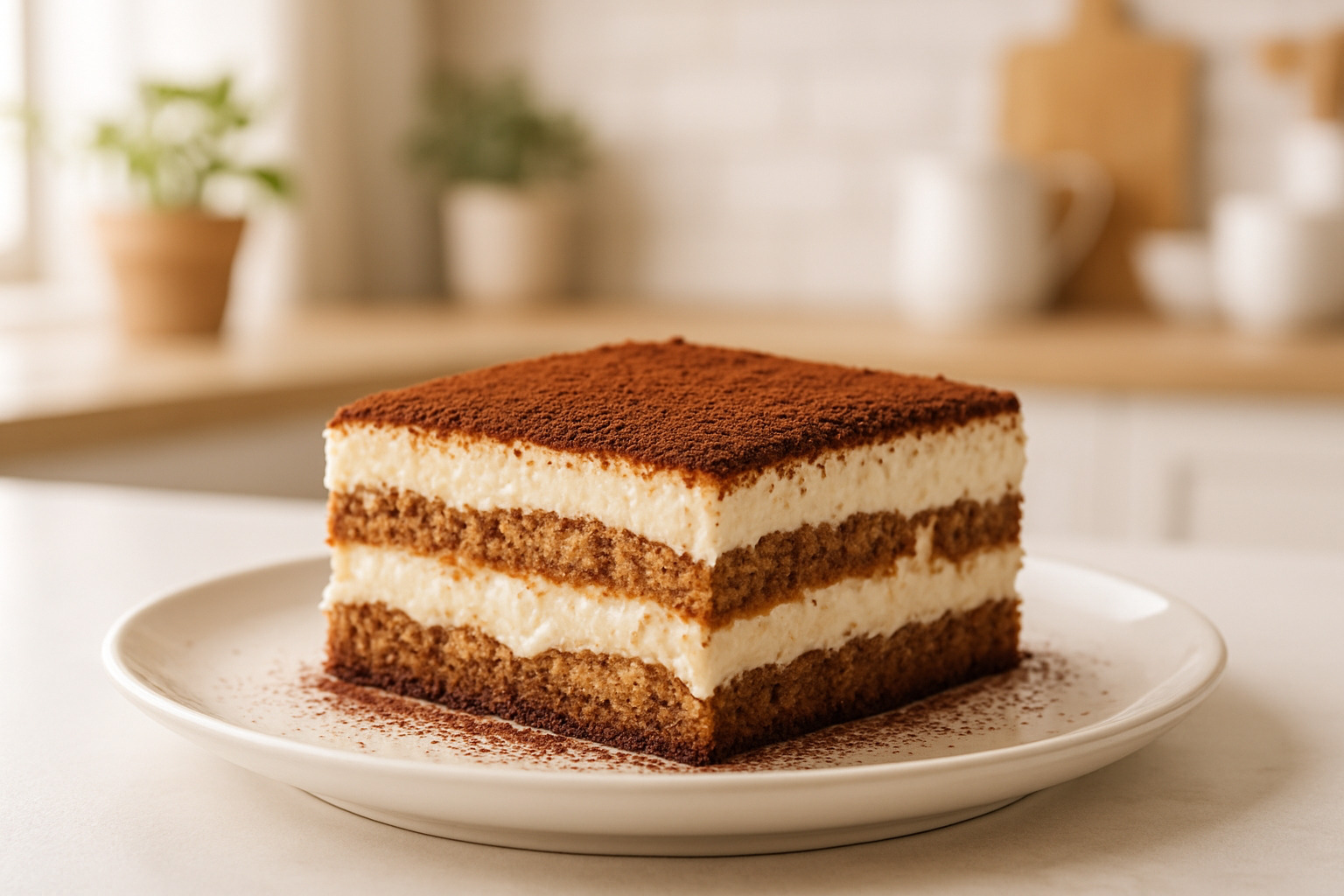
But mascarpone’s talents extend far beyond the dessert table. In savory cooking, it’s a secret weapon that adds luxury without overwhelming delicate flavors. Stir a few spoonfuls into mushroom risotto during the final minutes of cooking, and watch it transform into restaurant-quality silk. The high fat content means it won’t curdle like lighter dairy products, making it perfect for pasta sauces that need to stay smooth and creamy.
Try folding mascarpone into your mashed potatoes for the creamiest side dish imaginable, or use it as a finishing touch for soups and sauces. Its mild flavor won’t compete with other ingredients – instead, it creates a luxurious backdrop that makes everything taste more refined.
More info about French Desserts
Can Mascarpone Be Eaten on Its Own?
Absolutely! High-quality mascarpone is delicious as a spoon-able treat straight from the container. Its natural sweetness and creamy richness make it feel indulgent without being cloying – think of it as Italy’s answer to clotted cream.
Spread it thickly on a toasted bagel for a luxurious breakfast that puts regular cream cheese to shame. The buttery flavor pairs beautifully with everything from fresh strawberries to a drizzle of honey. For an neat appetizer, serve mascarpone with seasonal fruit and perhaps a glass of Prosecco – it’s sophisticated simplicity at its finest.
Many food lovers find that mascarpone makes an excellent wine pairing companion. Its rich, mild flavor complements both sweet dessert wines and crisp whites without overwhelming the palate.
Tips to Improve or Pair the Flavor
While mascarpone is absolutely delicious on its own, certain additions can improve its natural buttery sweetness and create more complex flavor profiles.
For sweet applications, a few drops of vanilla bean paste transforms mascarpone into something truly special. Fresh citrus zest – whether lemon, orange, or lime – adds brightness that cuts through the richness beautifully. Try folding in some fresh herbs like mint with summer berries, or create texture with toasted nut crumble for a sophisticated dessert element.
In savory dishes, mascarpone loves aromatic partners. Fresh herbs like basil, thyme, or chives create wonderful contrasts, while a shot of espresso can add depth to both sweet and savory preparations. For special occasions, a few drops of truffle oil lift mascarpone into pure luxury.
The key is balance – since mascarpone has such a mild flavor profile, it welcomes bold additions without losing its essential character. Experiment with seasonal fruit, spices, or even a splash of your favorite liqueur to create signature combinations that reflect your personal taste.
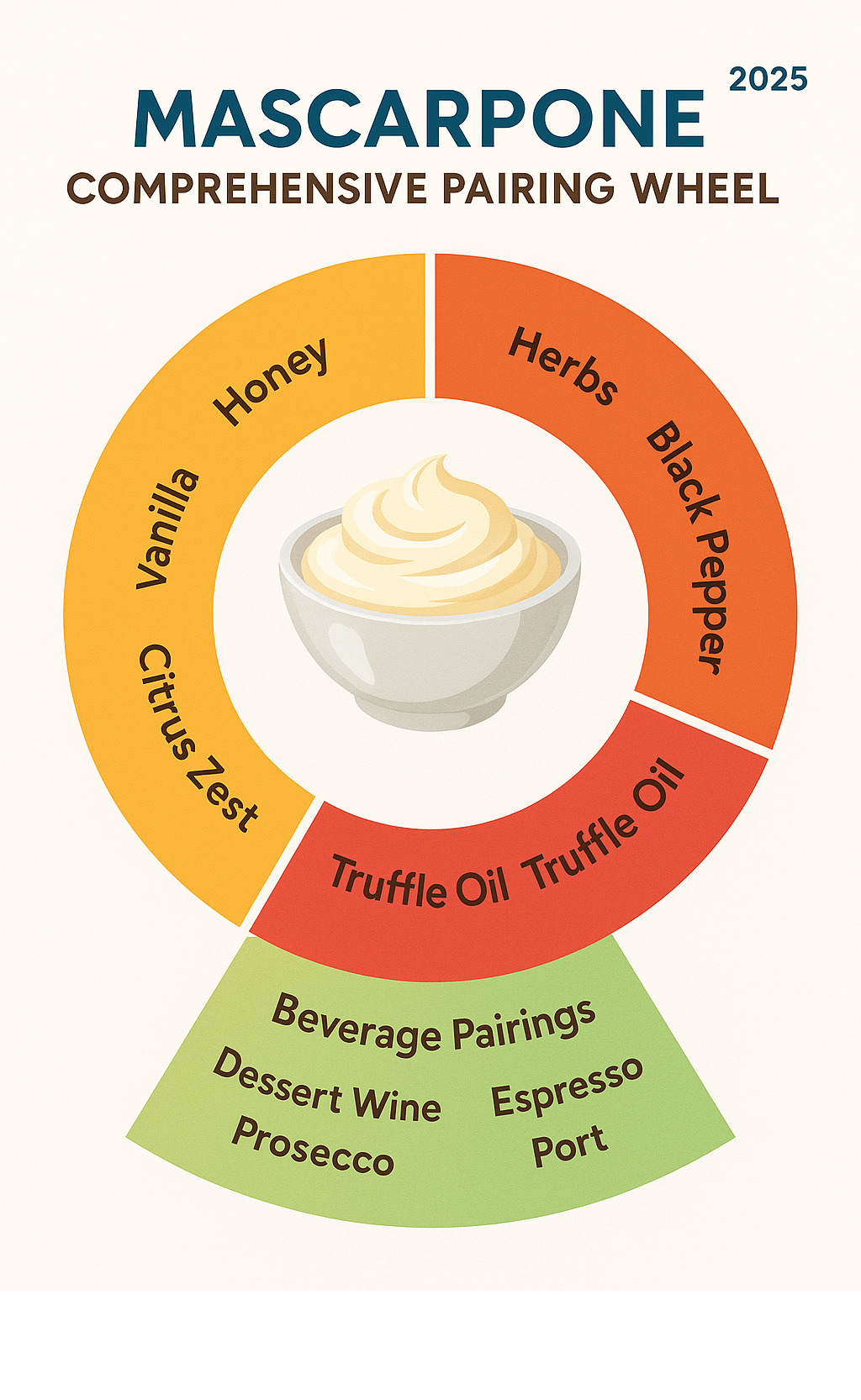
Buying, Storing & Dietary Concerns
Shopping for mascarpone can feel overwhelming with so many options, but knowing what to look for makes all the difference. You’ll find both imported Italian and domestic American versions on store shelves, each with their own personality.
Imported Italian mascarpone often delivers more complex flavor thanks to traditional production methods and exceptional cream quality. The taste difference is noticeable – richer, more nuanced, with that authentic what does mascarpone taste like experience you’d get in a Roman café. However, these premium versions come with a premium price tag, often costing 2-3 times more than domestic alternatives.
American-made mascarpone offers excellent value and wide availability. While it may lack some of the depth of imported versions, quality domestic producers create perfectly delicious mascarpone that works beautifully in most recipes.
When examining labels, look for minimal ingredients – ideally just cream and acid. Skip versions loaded with stabilizers or preservatives, as these additives can muddle the pure, creamy flavor and affect that signature silky texture. Always check expiration dates carefully since mascarpone is highly perishable.
Freshness indicators include a clean, sweet dairy aroma and bright white color. Avoid any containers with yellowing around the edges or sour smells. The mascarpone should look smooth and creamy through clear packaging.
Price varies dramatically based on origin and quality. For everyday cooking, domestic versions work perfectly fine. Save the splurge on imported Italian mascarpone for special occasions like homemade tiramisu or when you’re serving it simply with fresh berries where flavor really shines.
Eco-Friendly & Sustainable Choices
Making environmentally conscious mascarpone choices doesn’t mean sacrificing flavor. Local dairies often produce exceptional mascarpone while dramatically reducing carbon footprint from transportation. Many small-scale producers in regions around New York City create artisanal versions that rival Italian imports.
Organic mascarpone ensures the cream comes from cows raised without synthetic hormones or antibiotics. The pasture-raised difference often translates to richer, more complex flavors too – it’s a win for both your taste buds and values.
Some innovative producers are pioneering sustainable packaging and carbon-neutral production methods. These forward-thinking dairies often produce superior-tasting mascarpone while supporting the growing sustainable dining movement. Supporting these producers aligns perfectly with conscious eating trends while often delivering exceptional quality.
Look for small-batch producers who prioritize quality over quantity. These artisanal makers typically use cream from local farms, creating fresher products with unique terroir characteristics that reflect their region’s dairy heritage.
Frequently Asked Questions about Mascarpone Taste
When exploring what does mascarpone taste like, food enthusiasts often have practical questions about this luxurious Italian cheese. Let’s explore the most common queries that come up when cooking with or enjoying mascarpone.
Does mascarpone melt?
Here’s where mascarpone gets interesting – it doesn’t actually melt like regular cheese. Think of it more like butter warming up rather than mozzarella stretching on pizza. When heated, mascarpone becomes wonderfully fluid and silky thanks to its incredible 60-75% fat content.
This unique behavior makes it absolutely perfect for stirring into hot pasta dishes or finishing a creamy risotto. Unlike many dairy products that can curdle or separate when heated, mascarpone maintains its smooth texture and simply becomes more pourable. The rich, buttery flavor actually intensifies when warmed, making your dishes taste even more luxurious.
Can I freeze mascarpone without ruining taste?
The good news? Freezing barely affects what does mascarpone taste like – that delicate, sweet creaminess stays intact. The not-so-great news? The texture might get a bit grainy after thawing, losing some of that signature velvety smoothness we love.
If you do freeze mascarpone, use it within four months for best quality. When you’re ready to use it, thaw it slowly in the refrigerator and give it a gentle whisk to restore as much smoothness as possible. Frozen and thawed mascarpone works beautifully in cooked dishes like sauces or baked goods where the slight texture change won’t be noticeable.
Why is mascarpone less tangy than cream cheese?
This comes down to the fascinating science of cheese-making. Mascarpone gets its mild, sweet flavor from a completely different production process than cream cheese. While cream cheese relies on bacterial cultures that create lactic acid (hello, tanginess!), mascarpone takes a gentler approach.
Italian producers add acid directly to heated cream, causing it to thicken without developing that sharp bite. The acid gets neutralized during the process, leaving behind only the pure, buttery-sweet taste that makes mascarpone so special. It’s like comparing a gentle whisper to a bold shout – both are dairy products, but mascarpone keeps things delicately sweet while cream cheese brings the tang.
Conclusion & Next Steps
Now that you know what does mascarpone taste like – that perfect blend of buttery richness and gentle sweetness – you’re ready to transform your cooking trips. This remarkable Italian treasure isn’t just another dairy product; it’s your ticket to creating restaurant-quality dishes that’ll impress family and friends alike.
Think about it: with just one container of mascarpone in your fridge, you can whip up an authentic tiramisu that rivals any New York City Italian restaurant, create the silkiest risotto you’ve ever tasted, or simply enjoy a spoonful as an indulgent treat after dinner. The creamy, buttery flavor of mascarpone makes even the simplest dishes feel special.
For food lovers planning their next culinary journey, experiencing authentic mascarpone in its homeland adds incredible depth to your travels. But here’s the beautiful thing – you don’t need a plane ticket to start your mascarpone trip. Quality versions are available at most grocery stores, ready to lift your everyday cooking into something extraordinary.
At The Dining Destination, we know that understanding ingredients like mascarpone is what separates good cooks from great ones. Whether you’re exploring the latest dining trends or planning food-focused experiences, knowing these culinary building blocks helps you appreciate the artistry behind exceptional cuisine.
Your mascarpone journey starts in your own kitchen. Try it in a classic tiramisu, swirl it into your morning coffee, or spread it on toast with fresh berries. Each bite will remind you why this Italian masterpiece has captivated food enthusiasts for centuries.
Ready to explore how the food world is evolving? Find how sustainable practices are reshaping dining experiences and creating more meaningful connections between food lovers and the ingredients they cherish.

